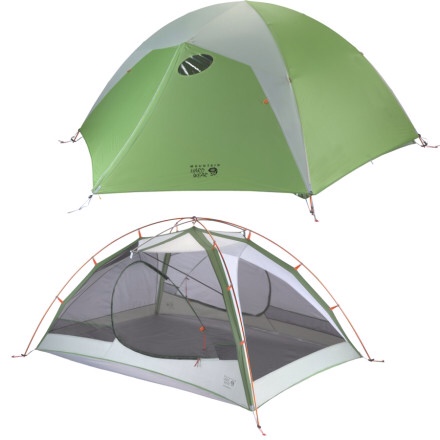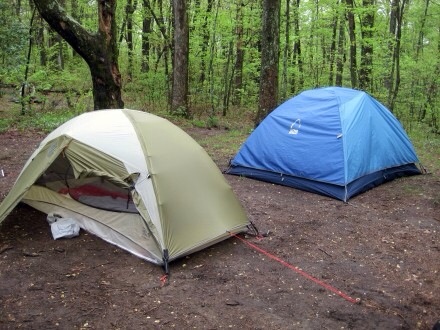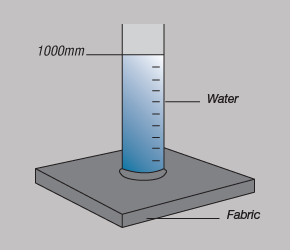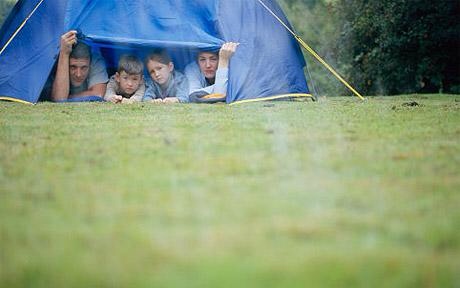Table of Contents
We chose the Mountain Hardwear Skyledge 3 tent based on Alex’s previous success and veritable love affair with the Skyledge 2 tent, and also on its colour. Green is simply advantageous when stealth camping in the wilderness, as it’s much easier to camouflage and pretend that one is a part of the shrubbery when one is not such an unnatural colour as bright orange, red or blue.
It weighs less than 2.5kg including the groundsheet, accessories and compression sack, which is fantastic considering its large size. It is simple to set up very quickly, using three poles, clips or “buckles” and teamwork. It’s watertight and surprisingly roomy. If it is packed using a Sea To Summit eVENT compression dry sack it squashes into a veritably negligible size for ease of storage, meaning it won’t take up too much precious storage space and won’t weigh our panniers down.
Update August 2013: After a year of heavy use, the Skyledge 3 tent has not made the distance. We still really like the Skyledge tent, however recommend it only for multi-week or multi-month trips. We’ve found the lightweight construction of materials and poles simply not sturdy enough for extended travel.
– You can read how our 2011 MH Skyledge 3 died HERE
– You can see our preliminary review of the latest 2013 model Skyledge 3 tent HERE
Price: $500 US
Weight: Poles/Pegs/Ropes (712g) + Fly (591g), Inner (785g), Groundsheet (270g), Compression sack (116g) = 2474g
Compression Bag Packaged Size: L 23cm x W 23cm x H 21cm
Pole Length: 48cm
Pros:
– Lightweight
– Freestanding
– Well-ventilated
– Green
– Ability to ‘internal pitch’
– Lots of vestibule space
Cons:
– Tent floor ‘waterhead’ rating is relatively low
– One of the clips that holds the inner onto a pole has already broken (not sure if it was our error or not)
Alleykat’s criteria for tent selection:
1. Lightweight
2. Well ventilated
3. Solid setup for inclement weather (guy ropes, stiff structure)
4. Two vestibules for storage of all of our gear
(4a. Merely the fact that tents have parts of them called vestibules, a little childish sniggering can go a long way when battling with the trials and tribulations of tent erecting in difficult conditions. Oh good, there’s another one. You work it out!)
5. Able to be set up practically anywhere (so long as there’s a little bit of ground to spare)
6. Being able to pitch the tent internally in the rain, starting with the fly (internal pitch)
7. Colour that will be best for camouflaging – green most chameleon-like.
8. Free standing tent. No reliance on guy ropes to maintain the tents structure – using pegs is optional.
9. Lots of space inside so that we aren’t feeling claustrophobic.
10. Groundsheet for protection.
11. Three season.
Three season, freestanding tent for world travel
We chose a three season tent for our world trip because it was lighter weight and good for the fair weather we are hoping for in most of the places we plan to go! Although we might experience varied weather including snow, wind and storms, we are not expecting this often. We now know that sleeping inside the Skyledge 3 is perfectly comfortable in Melbourne’s version of inclement weather but on the road, this may be more extreme, however, due to our “chasing summer” navigation plan, we are expecting warm nights relatively often.
Freestanding tents are great to use as they can be setup anywhere, without pegs if need be. Instances will undoubtedly arise where pitching our tent in the ‘perfect conditions’ is not possible and here lies a serious advantage in having a freestanding tent. Free standing or ‘geodesic’ tents, unlike tunnel tents, can be set up on virtually any ground the world throws at them. Examples of such ground when bike touring/camping are reputed to include rocky or extremely hard terrain, sand, concrete or even the floor inside a building. Also, given that freestanding tents hold their form, don’t have to be rooted to the ground and are incredibly light – cleaning is easy; all one must do is pick it up, tip it upside down and shake it out!
Waterproofness of the Skyledge
The materials tents are made out of these days are a far cry from the heavy and absorbent canvas tents of my childhood, and have certainly evolved since the use of wooden lattices and felt in the construction of gers. But, as with most technology, these materials have been improved around a theme. Material for tents needs to be weatherproof, light, strong, and importantly, water resistant.
The materials used in the Skyledge include polyurethane coated nylon taffeta and nylon ripstop material of various deniers (denier being a measurement of the number of yarns used to weave the fabric and thus its mass). All these technical terms mean that the tent will be strong but elastic (and therefore less prone to tearing) and extremely lightweight – the lower the denier, the lighter the mass of the material.
Importantly, the floor of the tent is 3000mm water head and the fly is 1500mm water head, meaning that respectively, these different parts of the tent can cope with 3000mm and 1500mm of water pooling on them before they allow water through.
These waterhead measurements are relatively low when compared with some other tents, however we highly value the lightweight properties of the Skyledge 3 and given the aforementioned hope we are holding for mostly fine weather, this will not affect us too much.
Skyledge 3 setup
Now that we have practised putting up the tent a few times, we’re getting to know the ins and outs of the process. Our mutual understanding of tents, tent-whispering if you will, mean that we knew some rules. Before even beginning to erect the tent, one needs to find a suitable area to fit the tent.
Once the best patch of earth has been settled upon, one must have all of the necessary parts. Inner: Check. Fly: Check. Pegs: Check. Poles: Check. Guy ropes: Check. What is missing? Why, the groundsheet of course!
Using a Groundsheet
Alex bought me a ‘footprint’ for Christmas (that, my fellow human beings, is where romance lies, in the surprises). The groundsheet aka ‘footprint’ is an integral but surprisingly lightweight addition to our tent. It protects the bottom of the tent from sharp objects and dirty surfaces.
There is a noticeable difference when sleeping with the footprint, including comfort and peace of mind because one is not preoccupied with the thought of great big holes being ripped in the bottom of the tent due to poor tent placement. Even if we had the sturdiest floor, I think we would still want a footprint!
Pitching the Skyledge 3 in the rain
Another advantage of using a groundsheet with the Skyledge 3 is the fact that it can be “internally pitched” during inclement weather, meaning we can be inside and dry(ish) much quicker.
We tested this method (albeit when it wasn’t raining) – it involves the same first few steps as any tent pitch: first (always) lay the footprint, peg down securely, lock together the main two tent poles and insert their ends into the footprint’s holds. This is where things go a little differently. Instead of unfolding the inner and clipping it to the poles, place the fly directly ontop of the poles, making sure the tent’s position is still correct – vestibules facing out from the long sides of the tent.
Once the ‘pitchlight’ setup of groundsheet, poles and fly only is complete, the inner can be setup in the dry. This all may sound a little complicated but it really is mostly intuitive.
Conclusion
The Skyledge 3 has satisfied Alleykat’s criteria: it’s green; it is sufficiently lightweight for packing into a pannier and lugging across the world every day; it is a three season freestanding tent that can be pitched almost anywhere, is strong and decently weatherproof; it is roomy inside so we can exist comfortably and easily caters for luggage storage with lots of space and suitable vestibules.
People world-wide continue to use and enjoy tents and it is clear there are many good reasons behind joining this camp-happy group. The occasional bed-sleep won’t go astray (I’m sure there’ll be space in the budget) but Alleykat is thoroughly delighted and excited to call the Mountain Hardwear Skyledge 3 our home for two years (or so)!







Cool tent. Looks very similiar to the MSR Hubba Hubba, which I have started using. Pretty intense review. Well done.
Thanks Nigel! Kat spent a lot of time on this one… not surprised you found it intense! I have used the MSR Hubba Hubba in the past and have found it to be great. The reason we didn’t go with the 3-person MSR version this time was the considerable weight difference between compared to the Skyledge. The MSR Mutha Hubba is over 800g heavier with a groundsheet!
I’ve recently bought a Tarptent Scarp 2 which is a extremely solid freestanding (with cross poles), 3/4 season (4 season with a solid interior and the cross poles) and pretty light (about 2.2kg packed, with a mesh interior and the optional cross poles).
It cost $370 for the mesh version with the optional cross poles and delivery to my door was $55. It’s an amazing looking tent and quite roomy given how much it packs down and how little it weighs. It unpacks quickly and doens’t expose the inner to the elements either, like any good hiking tent. I’ll be taking it for a field test next weekend, hopefully it’s as good in practice as it is in real life.
http://tarptent.com/scarp2.html#overview
I am a full time tourer so my tent is my home. I use the heavy yet useful Marmot Widi 3p. It is the only tent I’ve ever owned that has no issues after prolonged use(I’ve had it for 2 yrs now). After looking through all of your gear and travel lists the only glaring problems in your setup has to do with your camping gear. You need to update and get some camping gear thats comparable to your bike. Just saying. Nice blog.
Zllekk – please let us know where the holes are in our setup. We are really happy with all of our current gear, but love talking about how it could be better!
Hi ! Alee, I have purchased Mountain Hardwear Skyledge 3 tent at
http://www.omcgear.com/mountain-hardwear-skyledge-3-tent-2012.html
I see that you are the best user of this tent. I have gone through your reviews but a bit confused because of the manufacturing year.
Can you please tell me how you view of this 2012 model?
I am a mountaineer and usually go above 20000 feet.
Looking forward to your valuable comments. Thanking you in advance.